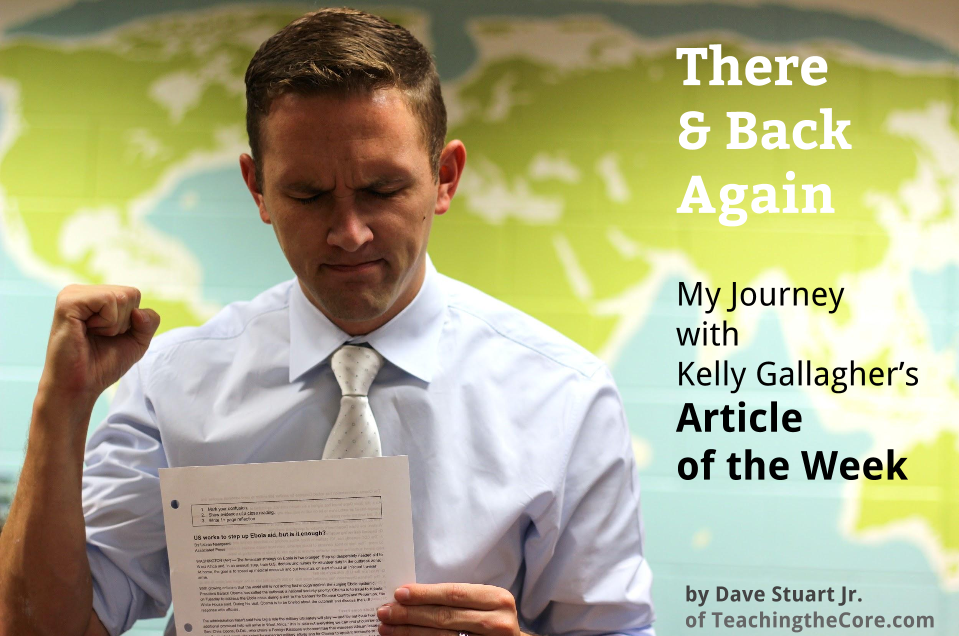

Before the Common Core were a twinkle in David Coleman's eye, Kelly introduced an assignment into his classroom called article of the week.
In the assignment, students read complex informational texts and responded to them in writing. That writing was nearly always a blend of the explanatory and argumentative modes, and it often culminated with a discussion of the issues in the text.
In addition to these academic practices, students began the assignment in class and completed it outside of class, meaning Gallagher's kids were getting a chance to develop their ability to manage their time outside of school (and thus they were developing academic self-control) with each assignment they completed.
Oh, and one more thing: this was a weekly assignment, giving Gallagher's students 40+ chances per school year to do all of these things.
Now look at the non-freaked out framework (below) that we sometimes talk about here on DaveStuartJr.com — circled in red, you'll find the elements of that framework that Gallagher's article of the week addressed:
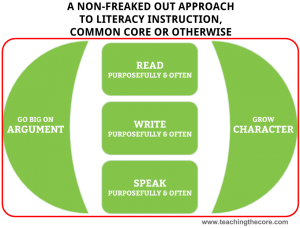
Gallagher basically created, in a single assignment, what it's taken me two and half years to just start figuring out. He is a Jedi.
My first exposure to the article of the week assignment
I first learned of Gallagher's AoW assignment in Readicide, where he argued that we need to “augment the curriculum with as much real-world text as possible” so that kids don't come across words like “al-Qaeda” in life and ask “Who's the Al guy?” (46). Gallagher continues on page 47 of Readicide:
“One way I addressed this problem [of students not having the background knowledge required for being multi-textual readers] in my classroom was by adding a weekly reading task I call ‘The Article-of-the-Week.’ These are real-world writings taken straight from news stories, essays, editorials, blogs, and speeches. I cull them from newspapers, magazines, and websites. Sometimes the articles are related to the unit we are currently studying and sometimes they are completely unrelated, but all the articles have one purpose—to broaden my students’ knowledge of the world. This past school year, for example, my students read and studied more than thirty different articles.”
When I first read this, I was intrigued, but not enough to make the jump. This had nothing to do with Gallagher's point and everything to do with me being an overwhelmed, “I'm long-term subbing in a new school in a new town with a new kid” dude.
But I couldn't escape Gallagher's wisdom; a year or so later, I was reading Mike Schmoker's Focus for the first time when Gallagher's article of the week came up again. From Focus:
For years, I have recommended that teachers set aside about one day a week to read current articles and opinion pieces, especially in English, social studies, and science… Author and high school teacher Kelly Gallagher actually does this. He calls it ‘Article of the Week.'… We should redouble our efforts to integrate current readings into the curriculum. If we can get students interested in the issues of their own time (and we can), they will be far more interested in issues, people, and literature of the past.
And so it was that, several years ago, I found myself sold on the idea and diving into the task.
(Since 2012-2013, I've kept a list of articles of the week on DaveStuartJr.com — you can check them out here. To go straight to the Fount, see Kelly's list here.)

My article of the week journey
I began teaching and assigning the article of the week assignment in my world history classes, and it's still in these classes (rather than my English ones) that I give the assignment. This isn't because I think AoW is an illegitimate use of English time — it absolutely isn't.
The simple reason for using AoW in my world history classes is because, basically, I can. Every single one of my ELA students is also in my social studies classes, and I like the “fit” of AoW better in the world history hour than the ELA one.
With that being said, if I taught only ELA, I'd still do the article of the week assignment. It's worth it.
Step 1: Using Gallagher's articles of the week
I began by simply heading over to Kelly's list of AoWs and using those with my kids.
Tons of benefit here: he and his colleagues are masters at picking articles from a variety of publications, on a variety of topics, and with a nice balance of explanatory and argumentative pieces.
Also, Kelly's articles of the week are blissfully simple in format and consistent in expectations (see below) — something that, as you'll see, I've strayed from over the years.

For more on the “flow” of article of the week, check out the video below:
Step 2: Creating my own articles using Gallagher's format
When I started finding articles of the week of my own, I initially used Kelly's format (pictured above). He has kids do three things (and you can bet he teaches and models how to do each of these):
- Mark your confusion. In other words, mark spots in the text where you get confused. “Embrace confusion” is a Gallagher-ism that made me a better teacher. The idea is that mature readers are not those who can read every text perfectly, but instead they are those who know where, exactly, a text is throwing them. Mature readers don't say, “I didn't get it. Like, any of it.” They say, “I started getting lost in the middle of the article,” or “I got thrown when the author mentioned Boko Haram in Nigeria.”
- Show evidence of a close reading. As I'll argue below, this basically means annotate. I tell my students I'm looking for 1-2 thoughtful examples of mature thinking (more on that below). I show them student examples that do exemplify this and those that don't.
- Write a 1+ page reflection. The goal here is for kids to respond thoughtfully to the article. Gallagher consistently provides 1-3 possible response questions that help kids who are stuck.
Step 3: Getting better at that hustle
Finding or creating articles was only the first step in my article of the week journey — it was then that the fun happened. I learned a lot of things the hard way as I grappled with how to really make the Gallagher-esque article of the week something that promoted the long-term flourishing of my students.
Here are some Article of the Week Domination Tips, to put a technical label on them, that I picked up in those initial years. It's worth noting that so much of what I learned I did in the community of life-dominating teachers I get to do the Teaching Dance with every day — one of them even has a blog herself, and you ought to check it out!
Hook it real good.
When motivation to read a text increases, the complexity of the text decreases. Tattoo this on your arm if you have to because it's one of the key truths we must cling to if we're to help our students read things they might not choose to read on their own. In the video below, I walk through a couple hooking strategies (that sounds wrong); I also write about one here.
Don't simply assign the article of the week; teach it.
This is simple but pretty important. As an educator who posts articles of the week on his website, I worry that some well-meaning teachers will simply print it, copy it, and assign it to kids, saying, “It's due Friday.”
That's not doing it right.
If doing the Gallagher approach to article of the week, we need to teach our students the three basic parts (see Step Two). To pose them as questions:
- How do I monitor my own comprehension of a text? Where do I tend to get confused in real-world texts? What do mature readers do when confusion happens?
- How do I stay focused while reading a text? How do I engage in a conversation with the author of an article while I'm reading? How do I work smarter not harder, so that I can both read the article and prepare for the one-page response at the same time?
- How do I respond to texts in a professional, thoughtful manner? How do I express my opinions on current issues while remaining grounded in a text? How do I organize my thinking in response to a reading?
At the start of the year, we're modeling the most elementary answers to these questions. As the year progresses, we want to keep pushing our students into greater degrees of sophistication in answering these questions.
For example, several weeks ago with my first AoW, I simply wanted students to get to the one page mark with their written responses. Based on what I saw in those responses, I wanted them to keep producing that quantity of writing, but then I also wanted them to use paragraphs (more than a few didn't) and to go beyond solely summarizing (some wrote responses that were 100% summary).
Teach it by modeling.
Going back to the three things Gallagher's AoW format asks students to do, it's important that kids frequently get to see us doing those things through brief, think-aloud modeling.
So if I'm modeling “marking confusion,” I'll choose a paragraph in the text where I legitimately stumbled as a first-time reader of the article. I try putting myself in my students' shoes, showing them how things like lengthy, complex sentences can be broken down into chunks.
Modeling is quick, on-the-fly work. While modeling a “move,” I explain the rationale behind it (this shouldn't be done just once at the start of the year! Our students deserve frequent and creative approaches to the “Why do I have to do this?” questions) and then do the move in front of them using a document camera. (By the way, if you don't have a document camera, make a Donorschoose request and get one — it's the most useful piece of teaching technology in my classroom.)
Teach it with exemplars.
I also love typing up 1-2 exemplary student-written responses each week. (Here are a couple examples of article of the week exemplar student responses from this school year.)
When using an exemplar, focus on 1-2 elements of the text that you want students to focus on with their current article of the week assignment. In the example linked to above, I wanted my students to notice 1) the use of paragraphs and, more importantly, 2) the reflective, “this is more than a summary” elements of each piece.
Instead of “close reading,” teach kids to annotate purposefully (read: DON'T have them fill the margins with busywork).
As I've written elsewhere, close reading has pretty much ceased being a useful edu-term. (I even wrote its obituary.)
With articles of the week, I want my secondary students to annotate strategically. The question they need to ask themselves any time they read is, “What is the purpose of me reading this text? What am I going to do with it?”
For AoWs, they know they need to write a 1+ page response to the article. So in the spirit of working smarter not harder, I teach them to respond to the article as they're reading it with margin notes (i.e., annotations) that respond to what they're reading. I explicitly state that 1-2 thoughtful, mature annotations per page is acceptable because quality annotations will lend themselves to writing the 1+ page response much more than mere quantity will.
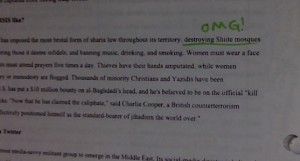
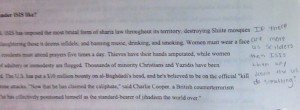
I can still remember a student named Caleb who struggled getting the written part of articles of the week done until he discovered that annotations could serve as a starting point for his written response. As is so often the case, Caleb's epiphany became my epiphany, and the seeds for this idea of teaching kids purposeful annotation were planted in my skull.
Regularly do it yourself.
When I actually try marking my confusion and strategically annotating toward the written response and then writing a 1+ page response, I get all kinds of insights into the article of the week assignment. I can feel the parts that are clunky, the parts that make me pause, and the parts that I've probably not taught well enough.
It also doesn't hurt my street cred with students when they hear that I, too, do the assignments I give them. We're a family and a team, baby.
Don't underestimate the power of the Friday discussion/debate.
At the end of each Gallagher article, there are possible response questions. In most cases at least one of these can only be answered argumentatively.

Just as I try to schedule fifteen minutes each Monday for teaching/modeling/getting students started with the article of the week, I also try to schedule fifteen minutes each Friday for a quick, graded discussion and/or debate. Even with large classes, it's possible to get every kid talking and getting some public speaking practice around the text in fifteen minutes — the pop-up debate strategy is a key routine for making this happen.
This is powerful, not just because speaking and listening are way undervalued in most classrooms, and not just because argumentative discussions can draw even the most disengaged students in, and not just because having these kinds of Friday rituals motivates more students to read the article of the week.
It's powerful for all those reasons and probably more. Don't under-estimate the power of this end-of-the-week fifteen minutes!
Step 4: Adding onto the Gallagher model (and possibly over-complicating it)
As DaveStuartJr.com readers began noticing last year, I made several tweaks to the Gallagher article of the week format based on several things I was learning in my teacher-book reading and through problems I was seeing in student performance on the article of the week assignment.
If Kelly Gallagher were to actually have visited my blog during this time period, he probably would have thought, “Oh good — this yahoo from Michigan has turned a one-page-front-and-back assignment into a several page packet. Awesome. The word ‘bastardization' has a new mascot, and it is Dave Stuart Jr.'s insane Frankenstein of an AoW.”
So let's look at how a simple assignment became a packet.
I want to explain the thinking behind each of the pages I added, and I'll go in the order that the pages appeared in a typical article of the week. (Here's a link to the article of the week I use for screenshots in the sections below.)
I added a rubric.
Before last year, I think there were only two teachers in my building using article of the week: my work sister Erica Beaton and me. But at the start of last school year, this expanded a bit as several additional teachers decided to augment their curriculum with the assignment.
This was a net win for kids in our building, but it did create one concern amongst teachers, parents, and students: grading wasn't standardized enough. One teacher was giving a 2/10 for articles of the week that were completed but had poorly written responses, whereas I was, in my head, giving up to 5 points for the reading and 5 points for the writing for a total of a 10 point assignment.
So people started asking me, “Well, surely there's a rubric for this thing, isn't there?”
And I was just thinking, Oh crap — everyone's going to find out that I just kind of go into a fugue state when I grade these things!
So I made the rubric, which you can see blown up if you click the image below.
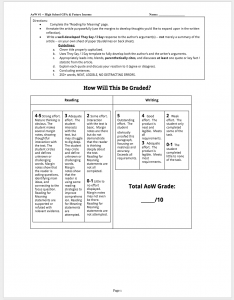
Strengths of this change:
- Clearly communicates to students, parents, and teachers how points are allotted.
Weaknesses:
- I'm not a rubric guru. I got into teaching because I want to help kids flourish long-term, and mastering the art of writing rubrics hasn't yet risen to the top of my personal PD list. All that is to say that my AoW rubric is by no means high-quality or guru-certified. That's why I'm pumped to start reading Rethinking Rubrics by Maja Wilson soon; E-Cash recommended it to me, and it sounds like a non-technical, thoughtful look at rubrics and whether they are actually awesome or not. For now, I just think it's worth stating that throwing a rubric on the front of an assignment doesn't automatically make it better or worse — that's where my head is on that.
- At least 4 of the 300,000 people who marched in NYC last week were there in direct protest of my paper-heavy AoW format, and that paper-heaviness began with this rubricky cover page.
I added Reading for Meaning statements.
Last fall, I read Perini, Silver, and Dewing's The Core Six, and in it the authors explain a strategy that I found pretty intriguing. While I explain Reading for Meaning comprehensively here, the gist of it is that mature readers seamlessly engage in before-, during-, and after-reading thinking with every text they read, and to help our struggling readers habituate these phases of reader thinking, we can use Reading for Meaning (RFM) statements. (Click on the image below to see a larger version of the example RFM page.)
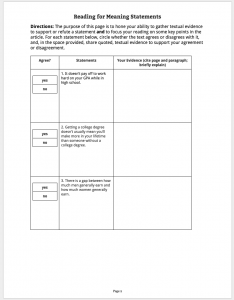
Strengths:
- The statements allow me to check specific comprehension points.
- They can serve as a hook into the reading.
- They lend themselves to Friday discussions/debates.
- They reinforce the idea that we need textual evidence to prove or disprove text-based statements.
Weaknesses:
- They add another page to the AoW, resulting in increased tree death and adding to the increasingly unwieldy feel of the assignment.
- They add another task for kids if you're still using Gallagher's three tasks.
I added several scaffolds for the written portion, including a self-editing checklist and a Graff/Birkenstein They Say, I Say two-paragraph template.
And then we get to the written portion. I was seeing several consistent problems in my AoWs, and so I sought to add elements into the assignment to help students dominate those problems.
First, I was seeing work that reflected no care for detail. We're talking about the lower-cased “i,” the uncapitalized proper nouns, the missing periods. I don't expect grammatical flawlessness (nor do I produce it as a professional writer *scratches back of neck*), but I do expect a best effort at conventional writing, and I think a certain standard is helpful for even my most struggling writers. Thus was born the self-editing checklist (see image below).
But then I was also noticing kids spouting off their opinions in response to the articles without any connection to the articles themselves. Students would say that we should close our borders and keep everyone out without any acknowledgment of the complexities of the issue discussed by the article's author.
This led me to pursue an argumentative bend to the article of the week, initially with the requirement that students use a two-paragraph They Say/I Say template a la Graff and Birkenstein, thus ensuring that kids would take the time to grapple with what an author actually says before joining the conversation.
All of this culminated with an additional page on the assignment and much, much more structure.
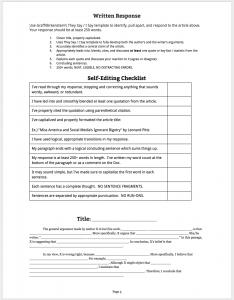
Strengths:
- Students had a list to which they could refer for self-editing.
- I was scaffolding argumentative responses for students with Graff/Birkenstein's two-paragraph template.
Weaknesses:
- I wasn't able to hold them accountable to doing the self-editing (not enough time to closely grade them). As a result, most students didn't use the checklist. It was there, it might have looked good, but it wasn't really used.
- The two-paragraph template isn't meant as a lock-step scaffold, but rather as a guide. It's meant to illustrate for students that we need to spend some time accurately representing the views put forth by a text's author before we bring our own views into the conversation, and it's meant to provide students with some sentence templates, some “moves” that can get that done. Unfortunately, many of my students began getting “stuck” with the exact words and phrases of the template (Erica Beaton, who now teaches last year's students, is working to unstick them
).
Step 5: Moving forward and backward at the same time (boom)
And that, dear reader, brings us to today.
To sum up Step 4, I took a smart, simple assignment and attempted to respond to the needs of my students and the pressures of my school by adding various scaffolds.
And don't get me wrong: I still see value in every one of those scaffolds.
Reading for Meaning statements are still a great strategy for getting kids to do the before-, during-, and after-reading thinking that mature readers do. Rubrics, until I read Wilson's book, still seem at least somewhat helpful for my students to know their way around an assignment. They Say, I Say is still a critical part of my composition instruction — that won't change. I plan to use the two-paragraph They Say/I Say template with my students later this semester, and I know that the they say is still something far too few of my students are doing in both their written and spoken arguments. And yes, I still want kids proofreading their work for the conventions we learn during the year, because details do matter.
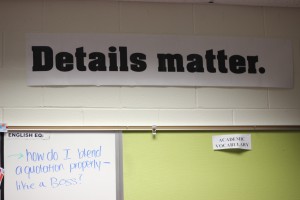
What I don't want to keep doing is including all these scaffolds with every single assignment. In doing this last year, I feel a bit as if I created a monster, and also as if I was working harder, not smarter (or at least I was making the copy machines work harder).
This year, I'm printing out the rubric once (and modifying the language — see next week's post) and giving it to kids to keep in their binders. If I use reading for meaning statements for a given article of the week, I'll do so on the article itself — but this won't be an every time element of AoWs, just as Gallagher's window quotes aren't an every time element of his.
For the writing pieces, these are again things I'll print out for students once. I'll include Graff and Birkenstein's two-paragraph template, as well as the more extended list of templates we use with kids.
So if you're one of the teachers who uses my AoW list consistently, I guess this is a 3,700-word note saying, “Be ready for more of the simple, elegantly formatted Gallagher-style articles of the week and less of the unwieldy, ‘Dave Stuart Jr. is a noob‘ packets.”
In next week's post, I'll provide some of those scaffolding documents I mentioned so that you can use them if you'd like.
In the meantime, thank Mr. Gallagher for the article of the week assignment. Let's see if he'll comment on this blog post and drop some knowledge for us.
Have a great day.
-Dave
Karen says
I am interested in how I might be able to use this in my 6th grade math classes. I found a couple of articles that I could possibly use; but, not really sure how to proceed. Is there a filter or filters that may allow me to search more effectively and efficiently? Thank you!
Kelly Gallagher says
Hi Karen. Take a look at my friend Kelly Turner’s Graph of the Week, which she uses in her HS math classes: http://turnersgraphoftheweek.webs.com/
davestuartjr says
Kelly, what a great resource — thank you for sharing this!
davestuartjr says
Karen, I once worked with a math teacher on the east side of Michigan who would use articles from a publication put out by NCTM. I want to say that articles were from Mathematics Teacher or Mathematics Teaching in Middle School. Check out those resources, too.
Sharon Ladner says
Karen, just a note on finding articles… Have you tried the website Newsela.com? It is a pretty cool site for locating newsworthy articles. You can sort by subject/grade.
whitney says
I love the articles of the week and newsela. Thanks for being my first year Godsend going from elementary to high school!
Sharon Ladner says
Awesome, Whitney! I love the high school level and wish you well as you move forward!
sherri says
As I attempt my first go around on AOW I can say that slow is good! I first am creating the routine, then focused on the annotation, now working on the writing, later the discussion. I figure I should be ready to go full by second quarter. I do give “eye ball” credit weekly (10 pts) for completion…in their low percentage homework column. I plan to have them choose one that I grade each quarter as an assessment. So rubrics and check list (which I like better than rubrics any way) are so helpful. So with that said, your journey has helped me start and process my journey. I am excited to get this going…it will mature as my 8th graders mature…which is growth I would expect to see. By the way…I teach a world current issues class…no better place for AOW.
Holly says
Dave, you are a boss. Your “Frankenstein” version of AoW has my team really fired up and on the the same page for the first time in a long while. It was the RFM and the rubric that helped me pitch AOWs to my team! We are making RFMs for all of our articles and it’s helping me grade smarter not harder. Thank you for sharing all of your work, and your meta-work. I’ve been following since the beginning, and I finally made the leap! Power to the mitten!!
davestuartjr says
Holly, power to the mighty mitten indeed. I’m glad to hear those pieces helped — in next week’s post I’ll dig into how they can still be a part of AoW without the “let’s print a book every week” business.
[Holds hand in the air in the shape of a mitten and points to where he’s from on his hand prior to hitting ‘Post Comment’]
Ron says
Dave– what grade level did you originally design this for?
davestuartjr says
Hi Ron,
I teach 9th graders, but I believe Mr. Gallagher teaches (or has taught) the entire 9-12 range with article of the week. I know there are many Teaching the Core readers who use the articles with younger grades as well.
Julia says
As I am entering my second year of AOW, I made a big change: Thursday is our listening and speaking day where we discuss the article in a variety of formats from partner share to socratic seminar, from debate to putting an idea on trial. The kids love this and it gives them practice using academic language while helping those kids who “just don’t know what to write about” come up with ideas for the response due on Friday. Last year when we had discussions on Friday, some of my students wanted to re-write their response to take in to consideration things that came up in the discussion.
Kimberly says
My students really need to discuss before they write. Discussions were often consuming all of our class time though, so I developed a strategy called 2 for 2. We use a two minute timer or the timer on their ipads. Students pick a partner and discuss the topic for two minutes. Rinse and repeat. Two minutes is just long enough to begin activating their thinking without allowing time for other discussion topics, such as “Did you see The Walking Dead last night?” Many of the students who are shy about participating or are clueless about what to say often repeat/reword what they heard their partner say in the first round. I am okay with this coping mechanism because it seems to build confidence along the way and then is used less.
Kelly Gallagher says
Dave has done what all good teachers do: take an idea and make it better for his kids. That said, I have one simple goal for the AoW assignment—that my kids get smarter about the world. Because of time limitations—and because of all the other things I have to teach—I have not created rubrics or taken the AoW deeper. Instead, I quickly check for understanding via a short weekly quiz I give every Friday (where the 1st question is always something about this week’s AoW).
For those interested in a math version of the AoW, check out Kelly Turner’s work: http://turnersgraphoftheweek.webs.com/
Sherri says
Love love love the “math” graphs of a week…has a serious place in a social studies classroom and science for that matters thanks for sharing this!
davestuartjr says
I do too. Those are high quality documents. Can’t wait to share these with more folks.
davestuartjr says
Kelly, thank you for your leadership and general life domination. You are a champion. I’m pumped for that next book of yours — the title alone has me eager.
Lynsay says
I love the idea of printing the scaffolds and rubrics once. I would love some more discussion on when and why you’d use Reading for Meaning statements vs. not. Concrete examples help best.
davestuartjr says
Hi Lynsay,
Great question — I will make a note of that for next week’s post, all right? In that post, I wanted to share some of these one-time-print-outs and walk through how I’ll be using them. Hope you are well!
Patti Harris says
I teach an Expository Reading and Writing for 12th grade and between Dave and Kelly and all the books I never have time to finish, my seniors love the idea of being able to think for themselves and to put their thoughts into words – providing valuable evidence for their claim. They like it so much that the 35 seniors that have class after lunch have, so far, not been tardy to class.
I started using Newsela.com last year and my district purchased the Pro version which allows me to monitor their reading and lexiles. It is an excellent source of timely and interesting articles and the reading level can be set by the teacher. One student confided that she reads even if there is no assignment.
AoW and Newsela and I am a happy camper (until I have to read them)!
Mary Clark says
Dave, this is so ridiculously great that I am going to share it with teachers and hover over them until they read it. Seriously, what you’ve built on Kelly Gallagher’s foundation is amazing. Like Patti Harris’s school, we now have Newsela Pro. I’d love to see teachers use your approach, then gradually allow students to choose articles of interest from Newsela and create a portfolio of their own AoW and responses.
I’m emailing the teachers now, but I will be tracking them down one by one and hovering tomorrow. Thanks to you, and to Kelly Gallagher, for the great work!
Mary
davestuartjr says
Mary, you got me laughing out loud with that image of you literally sharing it with them and then hovering until they read it. Oh my goodness, it is good to know you Mary Clark
That Newsela portfolio sounds sweet — I’d love to hear more about that as it progresses!
Audrey says
Dave, where should 5th grade teachers start?
These ideas look great but my kiddos need a more basic start.
I think there must be some things for them to start responding analytically.
Christy says
Audrey,
Try Time for Kids for middle school students!
Lynsay says
Dave and all,
1. Thanks!I kicked off the article of the week structure last week. I’m going simple. Know more about the world. Have informed opinions. Turn stuff in on time. Call me if you need help. Period.
2. Sharing! This is the article we’ll read this week, in case you/anyone wants it.
Summary: Stop worrying about Ebola and start caring for yourself in the most obvious of ways, preventing far more common causes of death.
http://www.nytimes.com/2014/10/15/opinion/frank-bruni-scarier-than-ebola.html
Becca says
I just set out to scaffold and make a rubric for AoW for teachers in my district…so thank you Dave for giving me something to work with using Kelly Gallagher’s great idea. It’s beneficial not to have to re-invent the wheel! I like both Kelly and Dave’s perspectives too, (mainly background knowledge v. scaffolding and rubric-ing more carefully.) I can actually see the different takes as a benefit to suggesting this assignment to teachers. Teaching teams at different grade-levels might choose which strategy they prefer, which means that they are getting what they want and incorporating an assignment useful to students.
davestuartjr says
Becca, I am glad to hear that this post and the one that came after it were helpful to you in moving AoW forward in your district. I think you are right to honor teacher autonomy with allowing for some choice in scaffolding.
Lynsay says
Dave, in the spirit of 80/20, would you be willing to share an editable copy of the rubric so I can tweak yours rather than make one?
davestuartjr says
Hi Lynsay — check out this post for just that resource!
Emily Ratica says
I have used Gallagher’s AotW assignment for a few years and I love it! I am totally using your ideas to improve though, I think it will enhance the experience even more for my ELA 10th graders. A few thing I added: TED talks – every Friday, before we discuss the article for that week, I show them a TED talk that relates to the article. If there is no TED talk, I find another educational video on YouTube (Crash Course, SciShow, Mental Floss, etc.) that deals with the issue in the article. My students love it and it really enhances our Friday discussions. Another slight change I made – I find articles that relate to our fictional reading (i.e. We are reading M. T. Anderson’s FEED right now, so all of the articles I use have to do with technology, advertising, teen social media use, etc.). This helps the students make connections between the text and the events of the real world, and increases their engagement/desire to read! Thanks for the inspirational post!
Kimberly says
Thank you so much for this idea, Emily. I have wanted to use Ted Talks but didn’t want it to be just another thing. I wanted it to connect to a larger picture.
Carrie Sweeney says
I love using articles of the week! I call it Non-Fiction Friday, and I only pick the argumentative/editorial type articles and use the “They Say, I Say” two paragraph structure. I struggle with how to grade it though and I’m thrilled to have come across your rubric, but I can’t seem to print it.
Julie White says
Dave, you are a BOSS! Thank you for making my first year at middle school so much easier!
davestuartjr says
Julie, thank you I am glad it has helped!
I am glad it has helped!
Amanda Dawson says
I am in my second year teaching 8th grade ELA and as I have been working with students this year I have realized that they struggle with non-fiction texts. I am moving to teaching 10th and 12th grade ELA next year. I want to use the AoW, but I have no idea where to begin. Can someone give me some direction? Please and thank you!
davestuartjr says
I would start with my interview with Kelly Gallagher about the AoW. You’ll find it here.
Jennifer says
Hi, Dave –
First of all, your post is a great starting point for a teacher that is looking to implement AoW this year! Thank you so much!
Secondly, as much as it would be “convenient” to follow your page this year and get the articles from those you post, I would like to know what you recommend in using as criteria to select an article for AoW. While I understand the purpose of current events, I am a bit confused at how to choose interesting topics that deal with life in general (for example, you chose “Why you should really start talking to old people more” as one of your AoWs). I know that we should consider things that the students would kid interesting, but obviously there are gaps in that level of interest from teacher to student. Thank you in advance for your help!
davestuartjr says
Hi Jennifer,
I just ask myself, “What’s happening in the world that I want my students to have a chance to know something about?”, or, “What ideas will my course not cover that I want my students to reflect upon?” (The “talk to old people” article is an example of the second one.) In my daily reading of articles, when I come across something that’s about the right length and I have a minute, I throw it into the Google Doc that’s formatted for my AoWs, and within a couple of minutes I’ve got another AoW ready to go.
I hope that helps!
Michelle Bulin says
Hi Dave,
I’m looking at trying to incorporate this into the Thought Question part of Achieve 3000 with my 7th graders. I would forgo the supplied Thought Question and have the students respond to the article in just a few paragraphs. Have you heard of anyone else doing this?
Thanks!
davestuartjr says
I have not, Michelle, but I wish you luck!
Lynsay Mills Fabio says
Friends! I tried something this quarter that balanced excellence with expediency, my needs with kids’ needs.
Routinely, I give the weekly AoW a five-second once-over and issue an A, C, or F as a homework grade. I kept noticing that kids were making the same mistakes over and over, even though I pointed them out in mini-lessons. Clearly, they needed more individualized feedback– confirmation that yes, this introduction was well-crafted, or no, this evidence does not support this claim.
At the end of this quarter, every kid picked one AoW — their best one — and turned it in for comments and a test grade. High quality support for them. Less grading for me. Everyone wins.
davestuartjr says
An excellent adjustment from an excellent educator — thank you for sharing, Lynsay!
Jennie Samples says
This is awesome!! I love the additions to the AOW, and think they will be a great tool to use on an as needed basis for the ones who struggle with the things you mentioned… may be a good starting place for grouping students who need help in different areas instead of giving all students all additions.
Thanks for this!
davestuartjr says
Thank YOU, Jennie!
Joseph Pisco says
Hi Dave!
I had a question about something that came up today when I was working with my 8th graders. We’ve been studying the Holocaust, and we were talking about Nazism and fascism, and our discussions and readings also made mention of Socialism and Communism, so, I decided to go with an article that described the differences between Capitalism, Socialism, and Communism.
Now, I know what you’re thinking — trying to explain these complicated political philosophies to 8th graders? That’s crazy! And you’d be right. The topic was way over their heads.I probably should have anticipated this, but I did find value in reading their annotations to see which specific parts were throwing them for a loop. The question I have, however, is what do you do when it’s clear kids aren’t understanding what they are reading in AoWs. not for lack of trying (bless them, they tried so hard), but because the material might be too complicated? Is there still value in exposure, even if there isn’t full comprehension? Thanks for your help!
davestuartjr says
Beautiful question, Joseph. I’ve experienced this plenty. The problems with the article you chose are probably:
1) the kids have too little background knowledge to understand the philosophies
2) the article might not be written for people with so little background knowledge
I do think 8th graders can handle that material, and I think you’re a great teacher for going for it. What I would do is find more articles that explore those ideas, maybe some things written down a bit more to the level of a novice. Basically, I’d spend a month or so of AoWs building their knowledge on the topic(s). Read more about this new approach at http://davestuartjr.com/bqy
Joseph Pisco says
Thanks, Dave! I think you’re spot on with what went wrong. Thanks for the link! I love the idea of big ideas being revisited though the burning questions approach. Thanks again!
Sherri Michalowski says
Also I find that a small lesson about the topic of the article helps…give them a bit of background info before they read. I also have them read one time in front of me with no annotations. This helps a lot too. BTW…I teach 8th grade.
Jessica Wright says
I was wondering if you are still doing the AOW? I noticed you did not share articles this past school year. Are you doing something different? I read your book and just ordered your new one. I love what you have shared and just wondered if I should consider an alternative to the AOW. Thanks!
Dave Stuart Jr. says
Jessica, you are right — during 22-23, I got away from it. I just needed a refresh for myself. I relied more on short-form videos and discussions. You need only consider this: is AOW filling my bucket right now? Or: do I want to try another way for increasing the knowledge-building opportunities I give to my students?
Martine says
Are you still doing article of the week? I want to start it with my grade 6 Science class. Some of my students are very low, but I think they need the push. Even starting with being able to produce 1/2 to 3/4 full pages would be great. Any revolutions about your way of doing AoW would be awesome.
Rachel says
New teacher here. Implemented AoW with my 85 7th and 8th grade students. How do you grade this efficiently so that you are giving feedback and not spending hours grading? My AP and Principal have said it is too much and I should cut back to Article of the month (or a bi-weekly article).
Dave Stuart Jr. says
Hi Rachel! You don’t need to give individual feedback on these assignments, as the purpose is knowledge building. Kelly and I both spend about 10 seconds per AOW giving a grade. You can hear him explain this in the interview we did recently: https://www.youtube.com/watch?v=Ar5UGHwlqgI